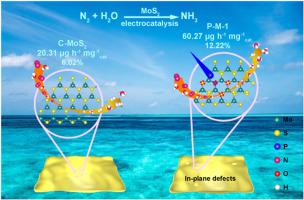Applied Catalysis B: Environment and Energy ( IF 22.1 ) Pub Date : 2021-09-20 , DOI: 10.1016/j.apcatb.2021.120733 Hao Fei 1 , Ting Guo 1 , Yue Xin 1 , Liangbing Wang 1, 2 , Ruoqi Liu 1 , Dezhi Wang 1, 2 , Fangyang Liu 3 , Zhuangzhi Wu 1, 2

|
Electrocatalytic N2 reduction reaction (NRR) serves as a promising approach for converting N2 to NH3 in a sustainable way to replace the energy-intensive Haber-Bosch process. MoS2-based electrocatalysts hold great potentials in catalyzing N2 reduction due to their similarity with active MoFe-co in biological nitrogenase. In this work, we reported a sulfur vacancy-rich MoS2 as an excellent electrocatalyst for NRR, where the sulfur vacancies (SVs) were easily controlled by regulating the amount of P dopants. MoS2 with abundant SVs (P-M-1) achieved a large NH3 yield rate of 60.27 µg h−1 mg−1cat. and high Faradaic efficiency of 12.22% towards NRR. Further mechanistic study revealed that P dopants not only created SVs as the active centers but also modulated the electronic structure for the enhanced adsorption and activation of N2 molecules, thus immensely promoting the catalytic performance of NRR.
中文翻译:

MoS2 的硫空位工程通过磷掺入改进电催化 N2 还原为 NH3
电催化N 2还原反应 (NRR) 是一种以可持续方式将 N 2转化为 NH 3以替代能源密集型 Haber-Bosch 工艺的有前景的方法。MoS 2基电催化剂在催化 N 2还原方面具有巨大潜力,因为它们与生物固氮酶中的活性 MoFe-co 相似。在这项工作中,我们报道了一种富含硫空位的 MoS 2作为一种出色的 NRR 电催化剂,其中硫空位 (SV) 可以通过调节 P 掺杂剂的量轻松控制。具有丰富 SVs (PM-1) 的MoS 2实现了60.27 µg h -1 mg -1的大 NH 3产率猫。和 12.22% 的高法拉第效率对 NRR。进一步的机理研究表明,P掺杂剂不仅产生了作为活性中心的SVs,而且还调节了电子结构以增强N 2分子的吸附和活化,从而极大地提高了NRR的催化性能。


























 京公网安备 11010802027423号
京公网安备 11010802027423号